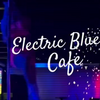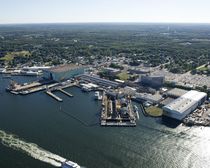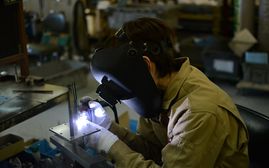Processing Your Payment
Please do not leave this page until complete. This can take a few moments.
- News
-
Editions
View Digital Editions
Biweekly Issues
- May 13, 2024
- April 29, 2024
- April 15, 2024
- April 1, 2024
- March 18, 2024
- March 4, 2024
- February 19, 2024
- February 5, 2024
- January 22, 2024
- + More
Special Editions
- Lists
- Viewpoints
- HBJ Events
- Business Calendar
- Custom Content
Electric Boat facing mounting challenges as sub work ramps up
 Photo | Wikimedia Commons
The USS Virginia, a Virginia-class submarine.
Photo | Wikimedia Commons
The USS Virginia, a Virginia-class submarine.
Washington – Earlier this month, Electric Boat broke ground on the centerpiece of the company’s expansion plan in preparation for the construction of a new line of submarines.
But a new Congressional Research Service report shows there are continued concerns about EB’s abilities to build the new Columbia-class ballistic missile submarine alongside the smaller Virginia-class attack submarines that have for nearly 20 years been the mainstay of that shipyard.
The report also cited a number of other problems in the construction of submarines by Electric Boat and its partner, Virginia’s Newport News Shipbuilding.
One is the result of a big change in the Virginia-class submarine program.
The Navy plans for Electric Boat and Newport News to continue to build two of these submarines a year, and three of them in 2023. The Virginia-class attack submarine was designed to be less expensive and better optimized for post-Cold War missions than older fleets of U.S. subs.
But the Navy wants to boost the attack power of the Virginia-class boat. The next block of subs will be larger, adding dozens of missile tubes and about 85 feet to each of the new Virginia Payload Module (VMI) subs. The cost will also increase, from about $2.8 billion to roughly $3.2 billion for each submarine.
Last spring, Electric Boat and Newport News struggled to meet scheduled delivery times as the Virginia-class program transitioned from production of two “regular” Virginia-class boats per year to two VPM-equipped boats per year.
“As a result of these challenges…the program has experienced months-long delays in efforts to build boats relative to their targeted delivery dates,” the report said.
The shipbuilders have also had problems with design work and welding.
“Program officials said vendor quality issues with welding on VPM have caused a 3.5-month delay in the schedule for the payload tubes for the first two submarines with VPM,” the report said.
Right now, Congress is struggling to pass a 2020 defense budget that would substantially boost the Navy’s budget for submarines. The CRS said “another issue for Congress concerns three Virginia-class boats that were reported in 2016 to have been built with defective parts, and the operational and cost implications of this situation.”
Electric Boat declined to respond to concerns raised in the report, referring all questions to the Navy.
The Navy had no response to the issues raised in the report.
The U.S. Senate, in its draft 2020 defense spending bill, demanded the Navy submit a slew of reports on the Virginia-class submarine program by October 1. Those include reports on the cost to repair the rubber-like quieting material that has started to peel off the hulls of the newer Virginia-class subs.
But the bigger problem is staffing.
In 2021, construction of the massive, new Columbia-class ballistic submarine will coincide with the continued construction of the Virginia-class subs.
Once the Virginia Payload Module is added, Virginia-class subs will require 25% more work. And the Columbia subs will require about 2.5 times more work than an original Virginia sub.
To prepare for the boost in construction, the workforce at Electric Boat’s shipyard in Quonset Point, R.I., where the Columbia is already in production, has been increased from about 2,000 workers a couple of years ago to roughly 4,250 today, on its way to about 6,000.
But Electric Boat’s facility in Groton is facing a dip in employment before it ramps up its production on the Columbia.
The shipyard’s planned overhaul of the USS Hartford will help ease the dip in employment, but a gap in 2023 remains.
And, according to the U.S. Naval Institute, Electric Boat yards have significantly less experience per employee than they did previously. The average worker at Groton had 23 years of experience in 2010 and just 13 now, and the average Quonset Point worker had 15 years of experience in 2010 compared to 7.6 years now.
The Senate defense bill said “expanding the capability and capacity of the submarine industrial base workforce is imperative to keeping pace with Navy shipbuilding requirements.”
“Numerous manufacturing capabilities must be addressed, including the need for more qualified and Navy-certified welders,” the bill said. “The committee is concerned that the Navy-certified welding workforce may be insufficient to meet Navy demands on time with the required quality.”
The committee recommended the Navy increase its research and development budget for submarine workforce development by $8 million and “develop and implement a strategy for strengthening the workforce pipeline for critical defense industries, including new submarine construction.”
For nearly a year, the Navy and Electric Boat have been struggling to finalize a contract for “Block V” or the next group of Virginia-class submarines.
Yet Electric Boat officials were upbeat at the Sept. 13 groundbreaking ceremony for the yard’s $850 billion expansion project.
“We hope to continue to hire and train thousands of new employees and will help grow our supply base of more than 3,000 companies to ensure the successful execution of the Columbia program,” said Jeffrey S. Geiger, president of Electric Boat, at the groundbreaking ceremony.
Later that same day, amid mounting challenges, Electric Boat announced that within two weeks it would replace Geiger with Kevin Graney, president of General Dynamics’ NASSCO shipyard in San Diego.
And, as the Navy is months behind schedule getting its latest batch of Virginia-class subs under contract and no solution appears imminent, there are increasing concerns that Virginia-class delays will affect the Navy’s top acquisition priority, the Columbia-class submarine.
Most Recent
Related Content
850 Billion dollars? Who's paying for that? Can't be General Dynamics!

2022 Giving Guide
This special edition informs and connects businesses with nonprofit organizations that are aligned with what they care about. Each nonprofit profile provides a crisp snapshot of the organization’s mission, goals, area of service, giving and volunteer opportunities and board leadership.
Learn more
Subscribe
Hartford Business Journal provides the top coverage of news, trends, data, politics and personalities of the area’s business community. Get the news and information you need from the award-winning writers at HBJ. Don’t miss out - subscribe today.
Subscribe
2024 Book of Lists
Delivering Vital Marketplace Content and Context to Senior Decision Makers Throughout Greater Hartford and the State ... All Year Long!
Read Here-
2022 Giving Guide
This special edition informs and connects businesses with nonprofit organizations that are aligned with what they care about. Each nonprofit profile provides a crisp snapshot of the organization’s mission, goals, area of service, giving and volunteer opportunities and board leadership.
-
Subscribe
Hartford Business Journal provides the top coverage of news, trends, data, politics and personalities of the area’s business community. Get the news and information you need from the award-winning writers at HBJ. Don’t miss out - subscribe today.
-
2024 Book of Lists
Delivering Vital Marketplace Content and Context to Senior Decision Makers Throughout Greater Hartford and the State ... All Year Long!
ABOUT
ADVERTISE
NEW ENGLAND BUSINESS MEDIA SITES
No articles left
Get access now
In order to use this feature, we need some information from you. You can also login or register for a free account.
By clicking submit you are agreeing to our cookie usage and Privacy Policy
Already have an account? Login
Already have an account? Login
Want to create an account? Register
Get access now
In order to use this feature, we need some information from you. You can also login or register for a free account.
By clicking submit you are agreeing to our cookie usage and Privacy Policy
Already have an account? Login
Already have an account? Login
Want to create an account? Register









1 Comments